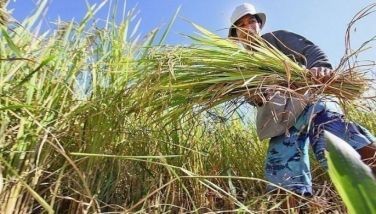Prawn industry players split over white shrimp issue
April 11, 2004 | 12:00am
Players in the local prawn industry are divided over the issue of whether government should maintain the ban on the importation and commercial propagation of the exotic Pacific white shrimp (litopeneaus vannamei) in the Philippines.
At odds are several Luzon prawn producers and the Negros Occidental prawn producers and other growers in southern Philippines or in the Visayas region which pioneered in the export of black tiger prawn prawns in the 1980s.
The white shrimp, coming mostly from Southeast Asia, was first introduced in 1979 in Iloilo then became popular in 1997 in Luzon, especially in Zambales, Bataan, Bulacan, Pampanga and Quezon.
Luzon prawn producers prefer the white shrimp over black tiger prawns which made many Negros Occidental prawn producers, and other producers in the south such as Roxas and Iloilo rich when the industry peaked in the late 1980s. In fact, several sugar plantation owners converted a portion of their hectarage to prawn farming to take advantage of the boom.
Black tiger prawns became a major agricultural export product but started to slow down in the early 1990s when it was overrun by competition, particularly Thailand which was more cost effective and sold its product to Japan, then the biggest market, at substantially marked down prices.
Thailand later also adopted the commercial production of the more prolific white shrimp and is now a major exporter of the shrimp variety, along with Indonesia.
In the Philippines, while white shrimp culture was becoming more acceptable in Luzon, the Bureau of Fisheries and Aquatic Resources (BFAR) issued Fisheries Administrative Order (FAO) 207 in 2001 which except for research purposes, prohibited the entry to the Philippines of live shrimps and prawns of all species and life stages from egg to spawner. Industry watchers said this was a result of lobbying done by the prawn producers in the Visayas who felt threatened by the growing popularity of producing vannamei or white shrimp.
Two years later, BFAR issued FAO 221 which regulates, but does not ban outright, the entry of all live aquatic organisms into the Philippines, including shrimps and crustaceans. All applications for imports should pass an import risk analysis (IRA) before being allowed entry into the country.
Since FAO 221 was issued after FAO 207, it is contended by some that it supersedes FAO 207. The BFAR said however that FAO 207 still holds since FAO 221 it merely amends another existing order.
Because the policy is not defined or clearcut, Luzon producers continue, despite the objections of their counterparts in the south, to grow white shrimp.
The Department of Agriculture and BFAR have so far, been unsuccessful in enforcing the ban and curb smuggling of vannamei fry.
Smuggling of vannamei is being practiced by both local and Taiwanese fishpond operators in the country. The usual modus operandi is to secure a permit from DA to import bangus (milkfish) fry which is allowed under FAO 221, and then misdeclare the vannamei fry as "bangus" fry. Traders are also finding other ways to bring the fry in without undergoing the scrutiny of quarantine and airport authorities.
In Luzon, there are an estimated 700 hectares of intensive and extensive white shrimp farms. Producers said they are making more money because the variety is hardy, it has a high survival rate, low feed conversation ratio, rapid growth during the first 60 days and capability to grow even if part of feed is substituted with lower cost tilapia pellets.
Vannamei grows faster and culture period, at 90-100 days, is less than the 120-185 days it takes for Penaeus monodon or black tiger prawn to be ready for harvesting.
Also, the average yield for vannamei is 9-15 metric tons per hectare of intensive farm, compared to 5-10 metric tons per hectare of intensive farm for black tiger.
A one-hectare intensive shrimp farm costs at least P870,000, compared to only P93,000 for a one-hectare extensive shrimp farm. An intensive farm is characterized by high stocking density, concrete ponds, water pumping, feeding with pellets and application of chemicals.
BFAR estimated that white shrimp is now illegally cultured in intensive farms totaling 250 hectares in the provinces of Bulacan, Pangasinan and Zambales. Aside from this, 450 hectares also culture the species using extensive methods.
The total average yield of the 250 hectares of intensive shrimp farms is 2,750 metric tons per harvest season, while that of 450 extensive farms is 650 metric tons also per harvest season.
Currently, the white shrimp yield or harvest constitute just 10 percent of total shrimp production in the Philippines. Production is sold locally and is substituting for suahe or metapenaeus ensis.
The other advantages include its adaptability for polyculture with milkfish.
"The extra income from shrimps even at low density makes the difference between profit and loss in milkfish pond culture," one grower in Zambales said in a recent forum organized by the Fisheries and Aquaculture Board of the Philippines (FABP) whose members come from various interest groups involved in pond, pen and cage rearing of fish and crustaceans, hatchery operations, feed milling, processing and domestic/export marketing.
(To be continued)
At odds are several Luzon prawn producers and the Negros Occidental prawn producers and other growers in southern Philippines or in the Visayas region which pioneered in the export of black tiger prawn prawns in the 1980s.
The white shrimp, coming mostly from Southeast Asia, was first introduced in 1979 in Iloilo then became popular in 1997 in Luzon, especially in Zambales, Bataan, Bulacan, Pampanga and Quezon.
Luzon prawn producers prefer the white shrimp over black tiger prawns which made many Negros Occidental prawn producers, and other producers in the south such as Roxas and Iloilo rich when the industry peaked in the late 1980s. In fact, several sugar plantation owners converted a portion of their hectarage to prawn farming to take advantage of the boom.
Black tiger prawns became a major agricultural export product but started to slow down in the early 1990s when it was overrun by competition, particularly Thailand which was more cost effective and sold its product to Japan, then the biggest market, at substantially marked down prices.
Thailand later also adopted the commercial production of the more prolific white shrimp and is now a major exporter of the shrimp variety, along with Indonesia.
In the Philippines, while white shrimp culture was becoming more acceptable in Luzon, the Bureau of Fisheries and Aquatic Resources (BFAR) issued Fisheries Administrative Order (FAO) 207 in 2001 which except for research purposes, prohibited the entry to the Philippines of live shrimps and prawns of all species and life stages from egg to spawner. Industry watchers said this was a result of lobbying done by the prawn producers in the Visayas who felt threatened by the growing popularity of producing vannamei or white shrimp.
Two years later, BFAR issued FAO 221 which regulates, but does not ban outright, the entry of all live aquatic organisms into the Philippines, including shrimps and crustaceans. All applications for imports should pass an import risk analysis (IRA) before being allowed entry into the country.
Since FAO 221 was issued after FAO 207, it is contended by some that it supersedes FAO 207. The BFAR said however that FAO 207 still holds since FAO 221 it merely amends another existing order.
Because the policy is not defined or clearcut, Luzon producers continue, despite the objections of their counterparts in the south, to grow white shrimp.
The Department of Agriculture and BFAR have so far, been unsuccessful in enforcing the ban and curb smuggling of vannamei fry.
Smuggling of vannamei is being practiced by both local and Taiwanese fishpond operators in the country. The usual modus operandi is to secure a permit from DA to import bangus (milkfish) fry which is allowed under FAO 221, and then misdeclare the vannamei fry as "bangus" fry. Traders are also finding other ways to bring the fry in without undergoing the scrutiny of quarantine and airport authorities.
In Luzon, there are an estimated 700 hectares of intensive and extensive white shrimp farms. Producers said they are making more money because the variety is hardy, it has a high survival rate, low feed conversation ratio, rapid growth during the first 60 days and capability to grow even if part of feed is substituted with lower cost tilapia pellets.
Vannamei grows faster and culture period, at 90-100 days, is less than the 120-185 days it takes for Penaeus monodon or black tiger prawn to be ready for harvesting.
Also, the average yield for vannamei is 9-15 metric tons per hectare of intensive farm, compared to 5-10 metric tons per hectare of intensive farm for black tiger.
A one-hectare intensive shrimp farm costs at least P870,000, compared to only P93,000 for a one-hectare extensive shrimp farm. An intensive farm is characterized by high stocking density, concrete ponds, water pumping, feeding with pellets and application of chemicals.
BFAR estimated that white shrimp is now illegally cultured in intensive farms totaling 250 hectares in the provinces of Bulacan, Pangasinan and Zambales. Aside from this, 450 hectares also culture the species using extensive methods.
The total average yield of the 250 hectares of intensive shrimp farms is 2,750 metric tons per harvest season, while that of 450 extensive farms is 650 metric tons also per harvest season.
Currently, the white shrimp yield or harvest constitute just 10 percent of total shrimp production in the Philippines. Production is sold locally and is substituting for suahe or metapenaeus ensis.
The other advantages include its adaptability for polyculture with milkfish.
"The extra income from shrimps even at low density makes the difference between profit and loss in milkfish pond culture," one grower in Zambales said in a recent forum organized by the Fisheries and Aquaculture Board of the Philippines (FABP) whose members come from various interest groups involved in pond, pen and cage rearing of fish and crustaceans, hatchery operations, feed milling, processing and domestic/export marketing.
(To be continued)
BrandSpace Articles
<
>
- Latest
Latest
Latest
February 24, 2025 - 6:28pm
By Dominique Nicole Flores | February 24, 2025 - 6:28pm
February 19, 2025 - 7:28pm
By Dominique Nicole Flores | February 19, 2025 - 7:28pm
January 10, 2025 - 11:00am
January 10, 2025 - 11:00am
November 9, 2024 - 3:43pm
By E.H. Edejer | November 9, 2024 - 3:43pm
June 9, 2024 - 5:55pm
By Alberto Peña | June 9, 2024 - 5:55pm
May 24, 2024 - 10:00am
May 24, 2024 - 10:00am
Recommended



























